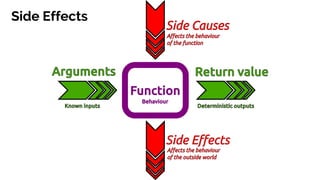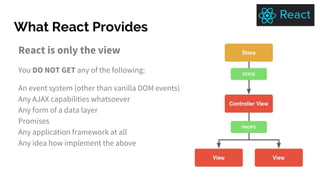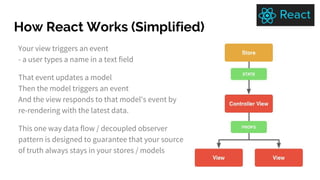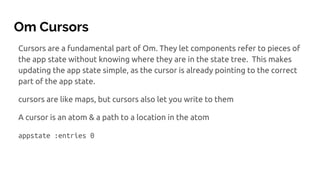Introduction to Functional Reactive Web with Clojurescript
- 1. Introduction to Functional Reactive Web by John Stevenson @jr0cket practicalli.github.io/clojurescript
- 2. @jr0cket Speaker, author, conference organiser & community obsessed developer. Love Clojure, Emacs, Cats, Cycling & Agile development. @Heroku @SalesforceDevs #Trailhead In a galaxy far, far away…
- 3. Why Functional Reactive Web it's not just because it's really fun...
- 4. Complex languages … are simply not easy to understand @jr0cket Josh Smith - Tweet Original Gif
- 5. The Complexity Iceberg - @krisajenkins ● complexity is very dangerous when hidden ● You can't know what a function does for certain if it has side effects
- 6. Side Effects
- 7. Pure Functions The results of the function are purely determined by its initial output and its own code - no external influence, a function only uses local values - referential transparency (the function can be replaced by its value)
- 8. Impure Functions - side causes The results of the function are purely determined by its initial output and its own code - behaviour externally influenced and non-deterministic
- 9. Eliminating Side Effects Functional programming is about eliminating side effects where you can, controlling them where you can't - @krisajenkins The features in Functional Programming come from a desire to reduce side effects
- 10. ClojureScript - Functional Web Immutability & composable functions for Web Apps
- 13. jQuery over all JavaScript frameworks
- 15. Google Closure tools & libraries
- 17. ClojureScript Quickstart Peeks under the covers of how to build and run Clojurescript generated JavaScript
- 21. Clojurescript Environments Nashorn - built into JVM, access Java classes - Oracle Nashorn: A Next-Generation JavaScript Engine for the JVM Browser-REPL - built into modern browsers (Chrome, Firefox, etc) - commonly used for client side web apps Node.js - great for command line utilities and microservices!
- 22. Common Clojurescript Tooling Figwheel (leiningen plugin) - defacto tool for client side web apps - live reload and so much more... Figwheel-sidecar - connecting Emacs to figwheel
- 23. Full-stack projects: Chestnut https://github.com/plexus/chestnut - leiningen template for Clojure/ClojureScript apps based - with Om, Reagent, or Rum - instant reloading of Clojure, ClojureScript, and CSS - browser-connected REPL included lein new chestnut project-name
- 24. Self-hosted Clojurescript Environments Instant startup times, great for command line tools Lumo (cross-platform) - https://github.com/anmonteiro/lumo Plank (Mac & Linux) - http://planck-repl.org/
- 25. Understanding React Basic concepts of React
- 27. React Basics React provides an efficient way to update the view
- 28. What React Provides React is only the view You DO NOT GET any of the following: An event system (other than vanilla DOM events) Any AJAX capabilities whatsoever Any form of a data layer Promises Any application framework at all Any idea how implement the above
- 29. How React Works (Simplified) Your view triggers an event - a user types a name in a text field That event updates a model Then the model triggers an event And the view responds to that model's event by re-rendering with the latest data. This one way data flow / decoupled observer pattern is designed to guarantee that your source of truth always stays in your stores / models
- 30. JSX JSX is a preprocessor step that adds XML syntax to JavaScript. You can definitely use React without JSX but JSX makes React a lot more elegant. Just like XML, JSX tags have a tag name, attributes, and children. If an attribute value is enclosed in quotes, the value is a string.
- 31. Reactive Frameworks All the varieties of life, plus all the Javascript varieties too...
- 32. Javascript & Clojurescript frameworks Javascript ● React.js via cljsjs ● Vue.js ??? Clojurescript ● Om / Om-next ● Reagent / Reframe ● Rum More at https://clojurescript.org/community/libraries
- 34. Reagent Reagent provides a minimalistic interface between ClojureScript and React. It allows you to define efficient React components using nothing but plain ClojureScript functions and data, that describe your UI using a Hiccup-like syntax. The goal of Reagent is to make it possible to define arbitrarily complex UIs using just a couple of basic concepts, and to be fast enough by default that you rarely have to care about performance.
- 35. Reagent Core functions reagent.core/render - Render a Reagent component into the DOM - First argument is either a vector (Reagent Hiccup syntax) or a React element reagent.core/atom - Like clojure.core/atom, plus it tracks components that deref atom & re-renders them
- 36. Reagent Helper functions clj->js - convert values from clojurescript to javascript js->clj - transforms JavaScript arrays into ClojureScript vectors, and JavaScript objects into ClojureScript maps
- 37. Reframe A micro-framework for Reagent
- 38. Reframe re-frame is a pattern for writing SPAs in ClojureScript, using Reagent. Being a functional framework, it is about data, and the (pure) functions which transform that data. It is a loop Architecturally, re-frame implements "a perpetual loop". To build an app, you hang pure functions on certain parts of this loop, and re-frame looks after the conveyance of data around the loop, into and out of the transforming functions you provide - hence a tag line of "Derived Values, Flowing".
- 39. Om / Om-next ClojureScript interface to Facebook's React
- 40. Om / Om-next Om allows users to represent their UIs simply as EDN. Because ClojureScript data is immutable data, Om can always rapidly re-render the UI from the root. Thus Om UIs are out of the box snapshotable and undoable and these operations have no implementation complexity and little overhead. See for yourself. Unique Features Om supports features not currently present in React: ● Global state management facilities built in ● Components may have arbitrary data dependencies, not limited to props & state ● Component construction can be intercepted via :instrument. Simplifies debugging components and generic editors. ● Provides stream of all application state change deltas via :tx-listen. Simplifies synchronization online and offline. ● Customizable semantics. Fine grained control over how components store state, even for components outside of your control. Simplifies using Om components outside the Om framework, debugging, and adding event hooks not anticipated by original component designer.
- 41. Om core functions om.core/IRender - Render a Om component into the DOM - uses reify to provide a specific implementation of the om/IRender interface om.dom/div attributes content - creates a <div> tag in react - all react tags need to be wrapped in a div in order to be rendered - om.dom/… has all the other tags too - h1, h2, p, a … (sablono can be used instead) #js - converts clojure maps into Javascript objects - nest #js functions to to create JS objects - eg. for inline styles
- 42. Om Cursors Cursors are a fundamental part of Om. They let components refer to pieces of the app state without knowing where they are in the state tree. This makes updating the app state simple, as the cursor is already pointing to the correct part of the app state. cursors are like maps, but cursors also let you write to them A cursor is an atom & a path to a location in the atom appstate :entries 0
- 43. Rum A micro-framework for Reagent
- 44. Rum Rum is a client/server library for HTML UI. In ClojureScript, it works as React wrapper, in Clojure, it is a static HTML generator. - Simple semantics: Rum is arguably smaller, simpler and more straightforward than React itself. - Decomplected: Rum is a library, not a framework. Use only the parts you need, throw away or replace what you don’t need, combine different approaches in a single app, or even combine Rum with other frameworks. - No enforced state model: Unlike Om, Reagent or Quiescent, Rum does not dictate where to keep your state. Instead, it works well with any storage: persistent data structures, atoms, DataScript, JavaScript objects, localStorage or any custom solution you can think of. - Extensible: the API is stable and explicitly defined, including the API between Rum internals. It lets you build custom behaviours that change components in significant ways. - Minimal codebase: You can become a Rum expert just by reading its source code (~900 lines).
- 46. Figwheel (flappy birds example)
- 47. Take your own journey into Clojure
- 48. @jr0cket @Heroku @SalesforceDevs #Trailhead In a galaxy far, far away… London, UK
- 49. Clojure - Functional Web Immutability & composable functions for Web Apps
- 50. Ring - simplifying communication Ring takes requests over HTTP and converts them into a map (think JSON)
- 51. Ring - creating an embedded server
- 52. Compojure - simplifying routing Compojure routes requests based on path & request type
- 53. Compojure - defining routes
- 54. Hiccup - html from Clojure
- 55. Ring - embedded server & dependencies























































